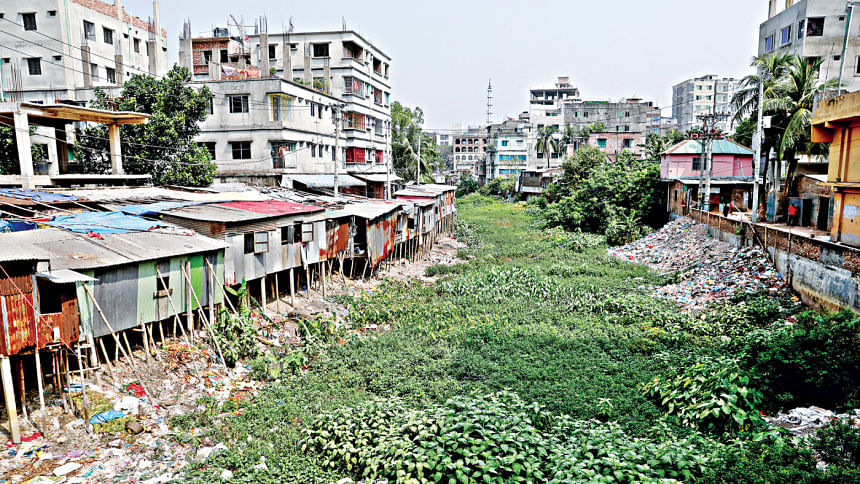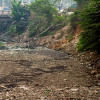Drainage disaster: Why Dhaka drowns every monsoon

The poor drainage system of Dhaka was once again exposed during the recent heavy rainfall that inundated large swathes of the city.
Non-stop rain that began on Thursday morning and continued into early Friday submerged numerous areas, including Shantinagar, Kalshi, Mirpur, Shewrapara, Green Road, Neelkhet, various parts of Old Dhaka, Bhashantek, Uttarkhan, and Dakkhin Khan.
According to the Bangladesh Meteorological Department, Dhaka received 196 millimetres of rainfall in the 24 hours beginning at 6:00am on Thursday.
Despite the two Dhaka city corporations investing more than Tk 262 crore over four years till 2024 in constructing 334.19km of drainage infrastructure, including box culverts and drains, the capital continues to suffer severe flooding during rain.
Experts blame indiscriminate filling of waterbodies and canals in the name of urban development, along with outdated and inadequate drainage systems, as the main causes of severe waterlogging in the city. They point out that the filling of flood flow zones has significantly reduced water-carrying capacity, intensifying the city's vulnerability to waterlogging.
A 2019 study by the Bangladesh Institute of Planners (BIP) revealed that Dhaka has lost 3,440 acres out of 9,556 acres of designated flood flow zones, retention areas, and waterbodies since the publication of the previous Detailed Area Plan (DAP-2010).
Adil Mohammed Khan, president of BIP, said the main reason for this persistent waterlogging is unplanned urbanisation that has destroyed waterbodies, canals, and flood flow zones.

He said a liveable city should have at least 35 to 40 percent of its area comprised of waterbodies and green spaces. In Dhaka, this has been reduced to around 10 percent.
According to BIP data, waterbodies covered 20.57 percent of Dhaka's central area in 1995. By 2023, this figure had dropped to just 2.9 percent. Similarly, green space has shrunk from 22 percent to only 9 percent over the same period.
Adil explained that while artificial drainage can reduce the duration of flooding, it cannot fully eliminate waterlogging if natural channels are destroyed.
Former BIP president Mohammad Fazle Reza Sumon said although water receded faster this time due to recent cleaning efforts in canals like Manda, Zirani, Shyampur, and parts of Sutivola and Dumni, problems remain.
He said tertiary drains connected to these cleaned canals have not been upgraded to handle rainfall above 400mm.
He stressed the need to revise the Wasa-2015 Drainage Master Plan, which was not designed to cope with the changing rain patterns caused by climate change.
A study by the River and Delta Research Centre identified 35 of the worst-affected neighbourhoods during last year's heavy rainfall, largely due to canal encroachment and narrowing.
For example, Pallabi, Shialbari, Rupnagar, and Eastern Housing suffer from severe waterlogging due to the narrowing of the Rupnagar Main Canal. Tolarbagh, Ahmednagar, and Paikpara flood because the Kalyanpur Main Canal, behind Bangla College, is completely encroached. In Shewrapara, Kazipara, and Kafrul, 80 percent of the Ibrahimpur Canal and 50 percent of the Kalyanpur Canal have been encroached.
The Panthapath Box Culvert is mostly blocked, causing flooding in Kalabagan, Dhanmondi-27, Kathalbagan, Green Road, and Hatirpool.
Rayerbazar and Jirani canals, about 80 percent occupied, lead to severe waterlogging in Hazaribagh, Nawabganj, Rayerbazar, West Dhanmondi, and Dhaka New Market.
In Rampura and Badda, waterlogging stems from obstructions in the Rampura Canal due to construction on the Banasree Main Road. Natural drainage routes through the Banasree Canal have been blocked, leaving low-lying areas like Khilgaon Chowdhury Para dependent on insufficient storm drains.
In Old Dhaka, areas such as Sutrapur, Wari, Nawabpur, Kazi Alauddin Road, Siddique Bazar, Narinda, and Tatibazar suffer persistent flooding due to the Dholai Canal (converted into a box culvert in 2007) being 90 percent blocked.
Jurain, Shyampur, and Rayerbagh are affected by the encroached Kadamtali and Manda canals. Kadamtali is 70 percent occupied, and Manda is clogged with garbage and polythene, the study pointed out.
Dhaka North City Corporation Administrator Mohammad Azaz said they are working round the clock to alleviate waterlogging.
"We identified waterlogging points after moderate rains this year and took steps to resolve those. We'll also act based on observations during this heavy rain," he said.
He noted specific problem areas. Shantinagar continues to flood due to incomplete drainage and box culvert issues. Waterlogging persists at New Market and BUET because of pending drainage work, he said.
Uttara Sectors 1, 3, and 4, as well as the Civil Aviation and Airport Road areas, are vulnerable due to the filling of a large waterbody on the eastern side of Airport Road for five government projects, he said.
Mirpur is affected by the clogged Paris Khal, which the city is currently cleaning, Azaz said. Kachukhet to Shewrapara remains waterlogged due to a road built over the Ibrahimpur Canal. Work is underway, but the solution will not be visible until next year, he pointed out.
Eighteen wards including Bhashantek, Ranabhola, Uttar Khan, Dakkhin Khan, and Kachpura have no drainage network. Infrastructure development is in progress and expected to take another one to two years, he added.
Meanwhile, most of the civic activities, including drainage cleaning, at the Dhaka South City Corporation remain halted over BNP leader Ishraque Hossain's swearing-in as mayor since May 14.

 For all latest news, follow The Daily Star's Google News channel.
For all latest news, follow The Daily Star's Google News channel. 







Comments